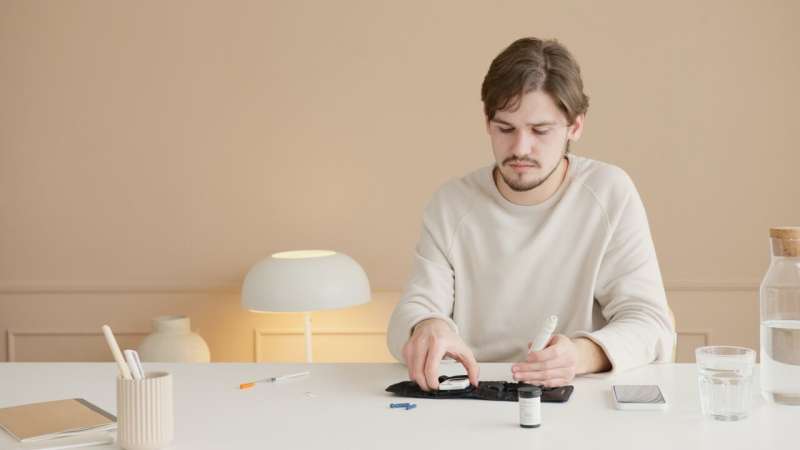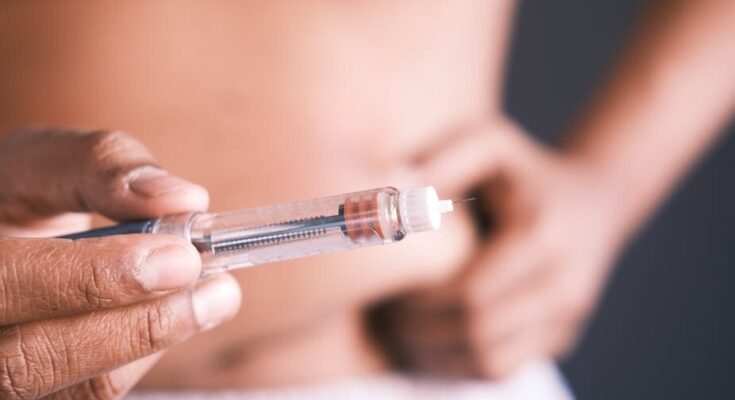
Approximately 4.5 million South Africans have type 2 diabetes—a condition characterized by high levels of sugar in the blood. It can be treated with drugs and managed through healthy eating and exercise. But if it’s not managed well, it can be life-threatening. Diabetes is one of the leading causes of death in South Africa.
Blood sugar levels rise to dangerous levels when the pancreas does not produce enough insulin, a hormone that regulates the movement of sugar in the body.
As diabetes progresses, insulin injections become the only treatment option. But the transition from oral medication to injectable insulin is often a bumpy one. Managing a patient on insulin requires patients to inject at least once a day and to measure their blood sugar levels at least twice a day. In addition, health care workers must have the knowledge, skills and time required to monitor patients and adjust the insulin dose when necessary.
To address this problem, we developed an intervention called the Tshwane Insulin Project. Our intervention combines various elements. One is a digital tool, the Vula app, which health professionals can use to communicate with each other.
Another aspect of the intervention involves community health workers in the care of people with diabetes. We also train health care professionals at primary care level to manage people living with diabetes, including those who need insulin.
Our intervention is a more efficient way of managing people with diabetes because health care providers share the tasks of patient education, insulin initiation and follow-up. The intervention also reduces the number of referrals from clinics to hospitals because of unavailability of doctors or lack of skills to manage patients on insulin.
The intervention
When a person’s blood sugar is not controlled with two drugs, they get the correct information about insulin and why it is necessary. If the patient agrees to go on insulin, the doctor prescribes it and the primary care nurse informs the patient.
The mobile app is very useful in primary health care settings because the doctor can send a prescription remotely using the app. Patients don’t have to wait for doctors to visit the facility. The nurse can check if the patient meets the criteria for insulin therapy and the doctor can confirm that, remotely, based on the information provided by the nurse.
Once the patient is initiated on insulin, the nurse contacts the community health worker team assigned to the clinic to inform them about the new patient.
Community health care workers are a very important part of this intervention.
Before the intervention, patients were sent home with a huge amount of information to digest by themselves. They would have to remember how, where and when to inject their insulin; how to draw the appropriate dose; how to measure their sugar levels; how to identify when their sugar levels are low (hypoglycaemia); and what to do at that moment.
Research shows that this can be overwhelming for patients. Some are illiterate, with limited medical knowledge. With the involvement of community health workers in the intervention, patients are no longer alone. Patients are visited at home every week. The community health workers remind patients of key education messages, injection sites and techniques.
The community health workers are also important in the adjustment of insulin doses. Before the intervention, most patients would have their insulin doses adjusted during clinic visits—which happened once a month at best—because they could not do it themselves. Insulin is always started at a low dose for safety reasons and to help the patient adjust. Then the dose is progressively increased until the optimal dose is reached. That optimal dose varies from one patient to another. When the dose is adjusted only once a month it takes too long to reach the ultimate dose. Many patients never reach that dose and remain with high glucose levels despite injecting.
With our intervention, during the weekly home visit, the community health workers communicate the blood sugar levels to the doctor via the mobile app. The doctor assesses the sugar levels and indicates whether the insulin dose should be increased, decreased, or maintained. With weekly dose adjustments, the patient reaches the optimal insulin dose faster and the condition is controlled sooner. The ability to adjust a patient’s insulin dose as often as weekly thanks to the team doing a home visit is a game changer.
The insulin project intervention was tested with a limited number of patients at ten clinics in the Tshwane district in South Africa. The results of this trial are promising. There was no report of low blood sugar, which meant that the intervention was safe. Patients who completed the 14-week follow-up with home and clinic visits recorded a reduction of their glycated hemoglobin or HbA1c by 2.2%, meaning that their blood sugar was better controlled after the intervention.
We are currently conducting a large-scale evaluation of the intervention.
Remaining hurdles
There is a lot of misinformation around insulin. As a result, some people with type 2 diabetes perceive the progression from oral medication to insulin as a sign of failure. Even worse, some believe insulin means that death is near.
We’ve also found high rates of insulin refusal by patients—as high as 50% in some areas. Many patients are not meeting their treatment targets. They remain on oral therapy with high blood sugar levels which leave them exposed to serious complications.
In addition, many health care professionals, especially those working at primary care clinics, are not equipped to manage patients who need insulin. Their lack of skills and knowledge may contribute to patients’ fears. And community health workers are in short supply. The number of community health workers is estimated at 55,000 for the whole country which is not enough considering the population needs. The Medical Research Council estimated that South Africa needs 41,000 more to bring the total to 96,000.
Despite all of these challenges, we are confident that interventions like ours can improve the management of people living with diabetes. The support of health authorities and health care workers is crucial for a successful implementation.
This article is republished from The Conversation under a Creative Commons license. Read the original article.![]()
Citation:
Technology and home visits can help South Africans with diabetes cope with insulin (2022, July 18)
retrieved 9 August 2022
from https://medicalxpress.com/news/2022-07-technology-home-south-africans-diabetes.html
This document is subject to copyright. Apart from any fair dealing for the purpose of private study or research, no
part may be reproduced without the written permission. The content is provided for information purposes only.
Source link




